As an Imperial Pacific island nation, perched on the edge of the world, it’s no surprise that over centuries the Japanese people have developed and held onto distinctive formalities that have persisted into contemporary culture.
Mastering at least the basics of Japanese etiquette will help you navigate this extraordinary unique culture and build lasting personal and business relationships.

The study of Japanese etiquette could last a lifetime or at least many trips to Japan!
What to Expect? In this article we’ll get you started on your journey with 34 Japanese etiquettes you must abide by to keep good manners in Japan.
Table of Contents
Why is etiquette important in Japan?
Tradition may be the last thing that springs to mind when you think of the ultramodern architecture and technological advancement of a city like Tokyo, but beneath the bright lights and multimedia is one of the world’s oldest social systems, where honor and nobility are highly esteemed.
In Japan, the knowledge and use of fine etiquette have been intricately linked to the estimation of a person’s moral character for centuries.

This is why the wrong manners and behavior in Japan can elicit such a bad reaction.
Conversely, efforts to know as much as possible about traditional behaviors and use them, even if clumsily, will earn you a warm welcome.
So let’s get started with some basic etiquette tips that should open doors.
34 Japanese etiquette you must abide by
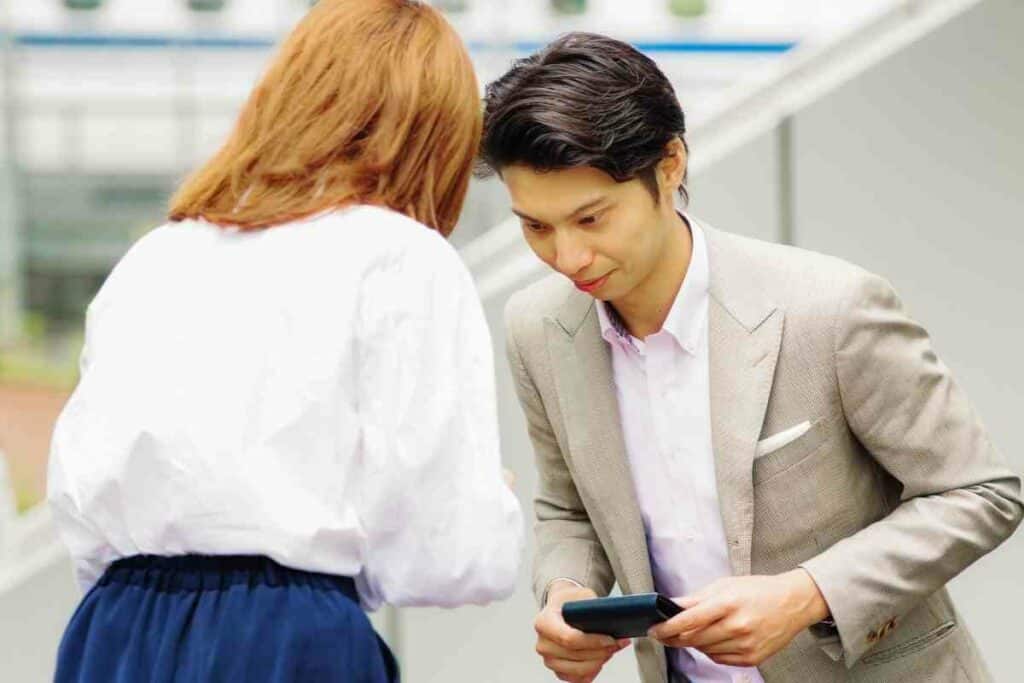
Greeting people in Japan
Saying hello is the first hurdle you have to cross in most interactions and thankfully the Japanese are immensely forgiving of a less than polished “Hi” and an offered hand.
However in formal and business settings how you say hello does matter.
Here are some pointers for greeting people while in Japan.
1. Include a bow
Not only do you need to bow, you need to use the right type of bow.
Your options include:
- A casual head nod – This is the type of bowing you do when you are greeted by a host at a restaurant. You can probably get away with using this less formal bow if you are unsure of what you should be doing.
- Eshaku bow – This informal bow is no more than a 15-degrees tilt of the upper body. Use it to say ”Hi” or “thank you”.
- Saikeirei bow – Use this 45-degree bend to the waist to show the person you are talking to gratitude or to make an apology.
- Keirei bow -This is a more formal bow of 30-degrees at the waist that is well worth using if you are a business traveler meeting clients or associates.
2. Know the right way to say hello
One of the most common Japanese greetings that is easy to remember is “Konnichiwa” which works great when couples with a head nod.
But if you want to be a little more authentic, the art of aisatsu (挨拶) or “greeting” is well worth exploring.
It has a high level of importance in Japanese society and is part of the public schooling there.

Here are some other friendly greetings you may want to try:
- Use Ohayō gozaimasu (おはようございます) to say good morning to someone.
- Use konbanwa (こんばんは) to say good evening to others anytime after 6pm.
- Use Ossu if you are casually greeting a Japanese male friend. It’s our version of “Hey man!”
- Use Moshi moshi or Hai when you pick up the phone.
- Yahoo or Yoohoo (ヤッホ) is a common greeting among children and young people.
3. Take care when addressing someone by name
In Japan, you use the surname before the given name.
This is really important when meeting someone for the first time or in a formal setting.
Stick to the surname unless you’re invited to use the first name otherwise you may be perceived as impolite or presumptuous.
A second thing to remember is to use the suffix “-san” when addressing someone, whether male or female.
So if you are speaking with someone new your address them with their surname followed by -san.
4. Handshakes aren’t a Japanese thing
Handshakes, daps, fist bumps, and ciphers need to be left at the airport as handshakes aren’t the done thing in Nippon.
However, many people know that foreigners shake hands and just might be prepared if you offer your hand.
Apologizing to others in Japan
The Japanese are very much like the British in being quick to say sorry.
The Japanese have over 20 ways to apologize, which vary according to the context where you are using it.

Here are some helpful pointers for apologizing well in Japan.
5. Choose the correct word for sorry
To get “sorry” right, you have to choose words that are appropriate for the situation you’ve found yourself in.
Here are some of the most common ways to say sorry to someone in Japanese:
- “gomen” ごめん is a quick and easy way to say sorry.
- “Warui warui” 悪い悪い is a quick way to say “my bad”.
- Use “gomen-ne” ごめんね of you are saying sorry to friends or familiars.
- Use “gomen-nasai” ごめんなさい for a more formal apology.
- “Sumimasen” すみません、 can be used as “excuse me” or “I beg your pardon”.
- You may want to drop the more formal “shazai” 謝罪 in a business email if you’re disturbing someone out of hours, or to be ultra-polite
6. Be quick to say sorry, even if you are unsure if you have done something wrong
Apologies are always welcome as they can quickly clear the air and restore the harmony that underpins the social order.
It may be difficult to know if you have offended someone as they often will not tell you.
Remember – The societal order in Japan means that people need prompt closure to slights or misunderstandings for everyone to move on.
7. Bow or even kneel to apologize if you have done something very bad
A really-bad tourist faux-pas, like trespassing on a shrine or throwing food to sacred koi, may require a more emphatic gesture.
Be prepared to bow deeply or even kneel to show the person you have offended that you take the matter seriously.
8. Keep saying sorry again and again until you’re stopped (and perhaps some more after)
This can show that you really mean your apology and understand that the receiving party may be hurt or offended.
It’s all about restoring harmony!
Essential Japanese public etiquette for the newbie
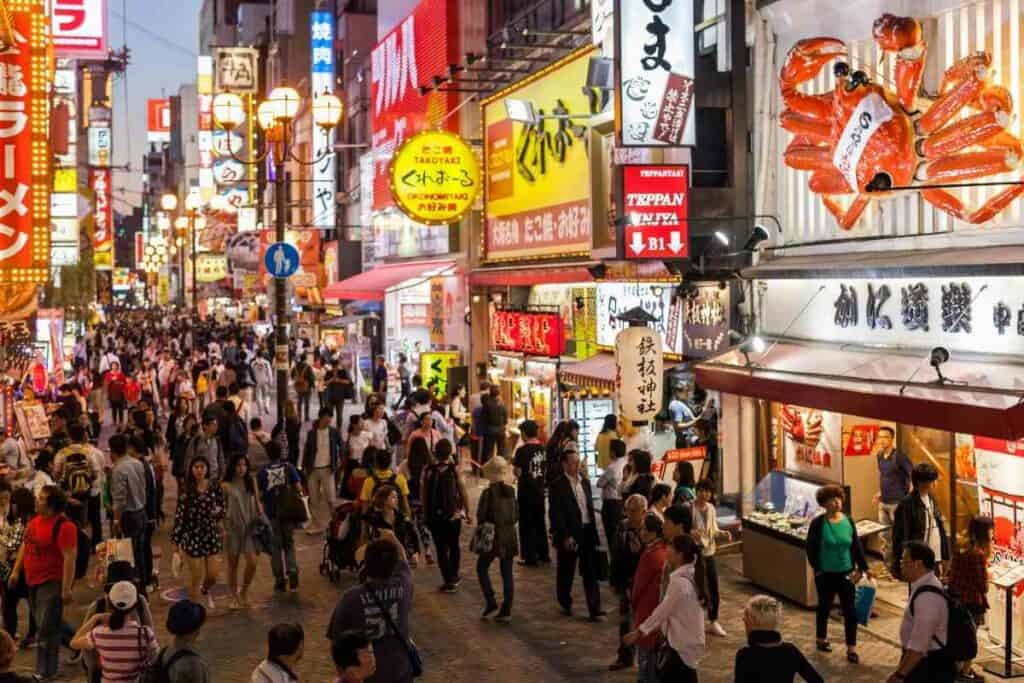
The vibrancy and distinctiveness of Japanese culture is a big draw for tourists, but the things that you can get away with in other international destinations may get you frowned at or even fined in Japan.
Here are the key etiquettes for public places in Japan.
9. Don’t point at people when you’re out and about
No matter how outlandish that Harajuku girl or Cosplay costume wearer is, keep your thoughts, opinions and pointing fingers to yourself.
Don’t Forget – Pointing is a great offense in Japan because others will think you are identifying the person you point out as a transgressor, or they have dissatisfied you in some way.
10. Walking while doing another activity is an absolute no-no
In Japan, walking is for walking and nothing else.
Smoking, eating and drinking, and having a conversation with friends while you are on the move are considered coarse behaviors.
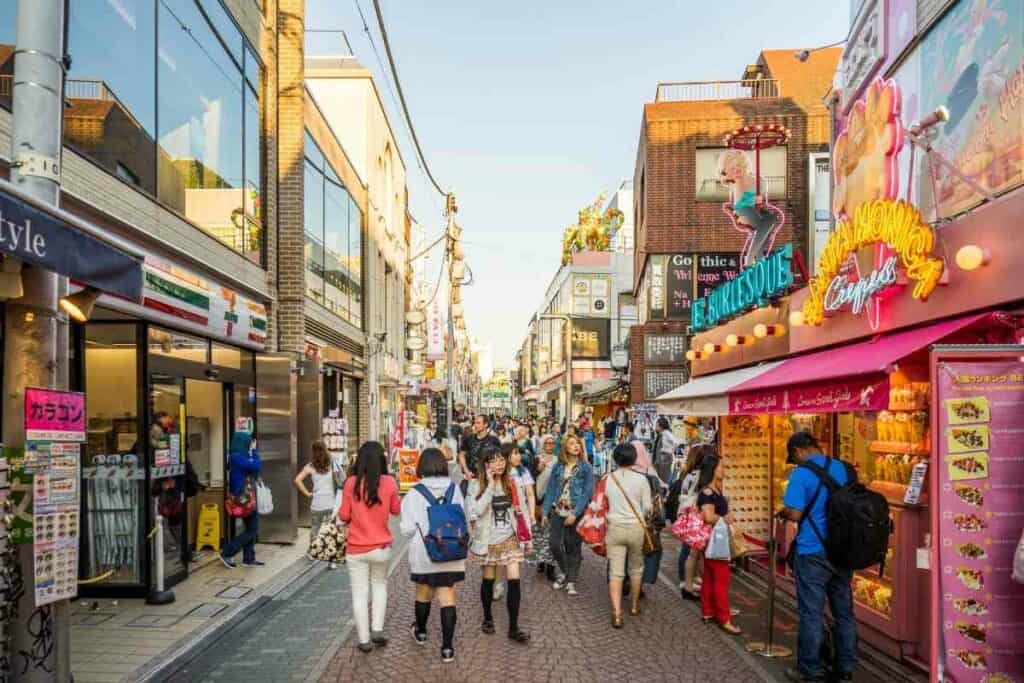
If you need to eat a snack or make a call, stand still and do it discreetly.
11. Avoid smoking openly
In Japan, smoking in public places is not banned but extensively restricted, with many locations and venues only allowing smoking in designated areas.
In many parts of Japan, smoking on the street can earn you a fine.
Walking while taking a drag on a cigarette is a taboo activity, and you’ll notice just how clean and cigarette butt-free the streets are.
12. No big noises in public places
If you’re sharing good times with friends outside in Japan, your exuberance will have to wait.
Japanese etiquette frowns on loud noises and rowdy behavior in public.
So rethink that raucous bachelor party!
13. Keep to the left
If you have traveled extensively in Europe, this may be easy for you.
But otherwise, actively remember to keep to the left side of the sidewalk or the roads if you drive.
Some parts of Japan have different rules, so following the locals is usually your best bet. (Nb. in Osaka, you should keep to the right!)
14. Don’t blow your nose in public
If you travel to Asia, the sheer number of people wearing facemasks in public places should warn you that blowing your nose is not going to be a welcome activity.
If you think about it, no one wants proximity to the tears and mucus of others.
Tip – If you need to use a hanky, head to a restroom to do it in private.
Japanese etiquette on public transportation
Bad manners on public transportation gives tourists to Japan a bad reputation.
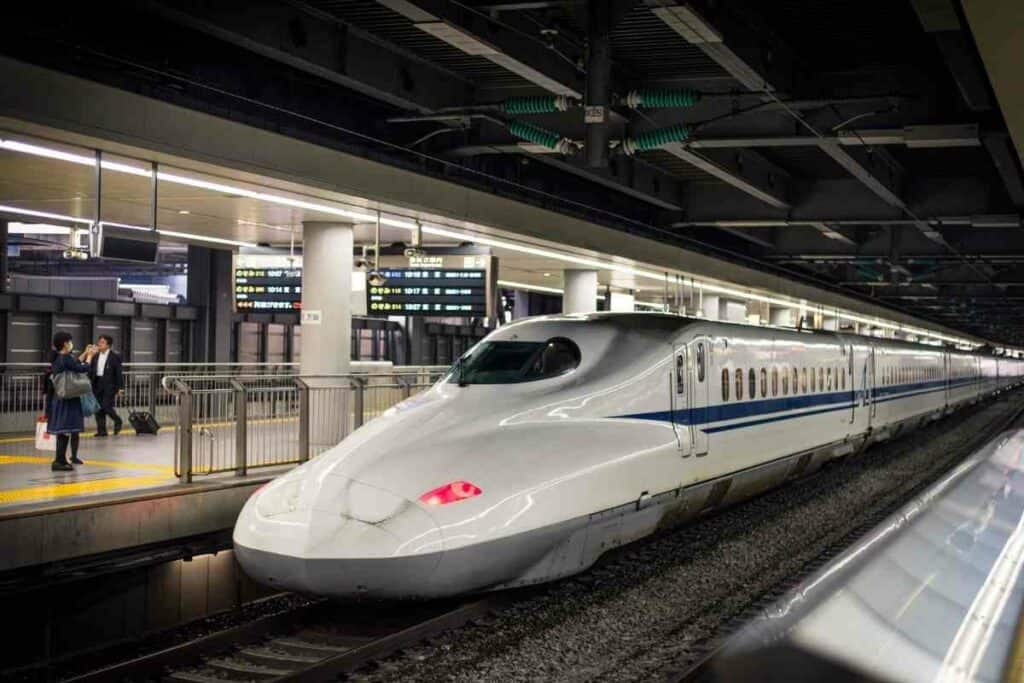
Being considerate of others helps everyone get along well.
Here are some pointers for good manners on public transport in Japan.
15. Keep it moving!
In population-dense urban districts, the foot traffic on trains and subways really needs to keep moving.
Don’t pause in the passages of stations for a chat or to check your map.
Try to facilitate the flow of people by moving quickly through ticket gates and entryways.
16. Move your luggage out of passageways
Obstructions really upset the flow and harmony people want to uphold while getting around in Japan.
Avoid standing in the middle of passageways with your luggage and watch that your wheelie bags don’t clip passers-by.
If you need to stop with luggage, move to the periphery of the concourse and find a quiet spot to arrange your things.
17. Obey the arrows
Keep people’s traffic flowing by observing any arrows or walking directions on stairs and passageways.
Places to queue, or where to wait for training are usually clearly marked on the platform floor.
18. Avoid walking on escalators and travelators
The Japanese transportation authorities would prefer you stand while moving on escalators or travelators, but in recent times, bad habits have even developed among the Japanese people.
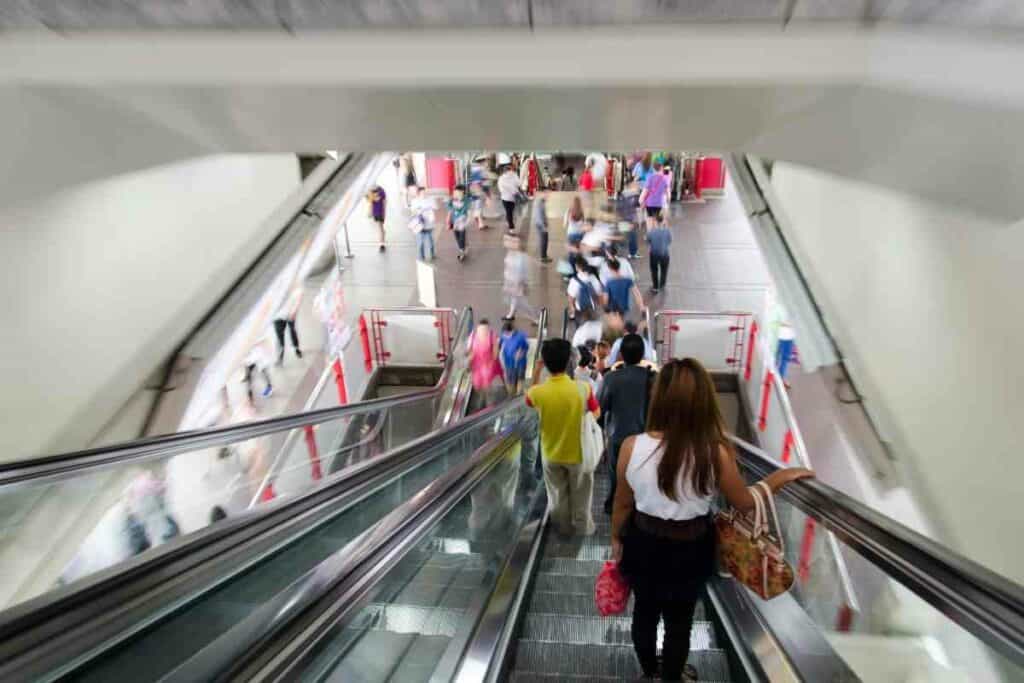
If you walk on an escalator during peak hours, you are likely to be forgiven, otherwise stand on the left and enjoy the ride!
19. Be prepared to queue
Scrum behavior has no place on Japanese public transport.
Politely and quietly join the queue, following any markings and visual directions in the station.
20. Remove your backpack on trains
Large backpacks take up space on seating and create an obstruction in the aisle of the train.
Take off backpacks and keep them by your feet, or between your legs if you are sitting, or ideally, use any available luggage racks.
Excellent Advice – If you have a lot of luggage, avoid traveling during rush hour or use one of the many delivery services to have it couriered from the airport to your hotel.
21. Be quiet!
People are expected to be quiet on Japanese trains.
It’s understandable given the long working hours and commutes many Japanese endure.
Having a loud conversation in person or by phone is one of the rudest things you can do.
Turn down the volume on headphones and set your mobile to vibrate.
On long-distance trains, a short, quiet phone conversation may be tolerated.
Dining etiquette in Japan
Dining is one aspect of Japanese living that is heavily infused with cultural traditions and rituals.
When dining with friends or in a restaurant, be prepared to abide by the customs and eating etiquette that has been honored for centuries.

These etiquette tips should turn you into a gracious Japanese diner.
22. Where and how you sit matters
Depending on where you eat, you are likely to have to sit down on a tatami mat.
Remove your shoes before sitting on the mat on your knees (the seiza position), or in a more comfortable cross-legged position if invited by your host.
Ladies should sit with their legs closed and their knees to one side.
Your position at the table is also important.
Did You Know? If you’re an honored guest, your host will offer you a position on the side of the table that is farthest from the door.
23. Put your chopsticks in the right place
The Japanese are particular about how to use chopsticks.
The most important thing to remember is to place your chopsticks in one of two places when you are not using them:
- Leaning on the provided chopstick rest
- Laying flat across the rim of your bowl
Leaving the chopstick sticking out of your food or soup is an absolute no-no.
24. Being a fussy eater is not a good look!
In any culture, a willingness to try the food your host serves you goes a long way.
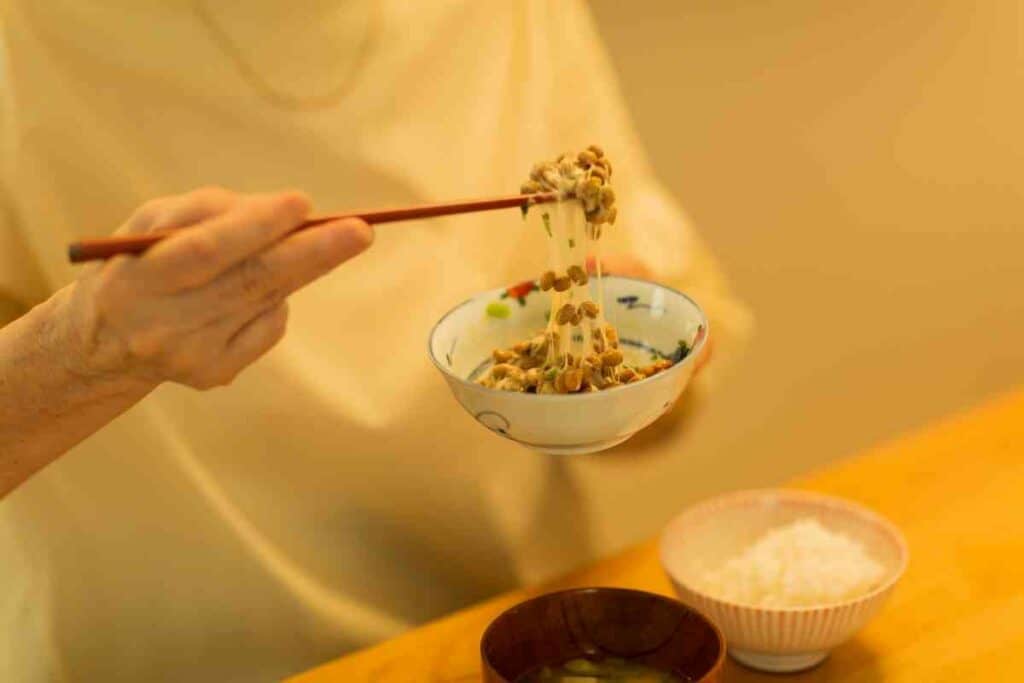
And it’s no different in Japan, so be prepared not to be picky or waste your food.
Japanese see this as a deep disrespect to the chef, farmers, and even animals who gave up their lives to provide you with a hot meal!
25. Let others fill your glass
When dining in Japan, let your host or server fill your glass.
This lets them know you feel they are doing a good job.
If you are dining with friends, you may fill your neighbor’s glass.
26. Don’t over-serve the soy!
If you’re someone who loves to drown their sushi in soy and spread wasabi thick, you will need to exercise restraint in Japan.
Pour a small amount of soy into the serving bowl at your meal and be careful not to totally drain it.
27. A good slurp lets others know your meal is satisfying

It sounds like the last thing you’d want to do at the dining table, but in Japan, it’s great to slurp your noodles.
Let yourself go and slurp your hot noodles to show your host just how much you’re enjoying your meal.
28. When you have finished eating, return your dishes to their places
Returning your dishes to their places, replacing lids, and placing chopsticks back on their rest is the polite way to finish your meal.
29. Put your payment in the tray provided
When you want to pay for your meal, don’t hand your money directly to the cashier.
Like some parts of Europe, the Japanese provide a tray for putting cash and cards to pay for food.
This tradition thrives because the Japanese predominantly use cash to pay for items.
Heads Up! Ignoring the tray and continuing to hand the money over is considered rude.
30. Tips are not expected
Tipping is not part of Japanese culture, so most restaurant staff won’t expect a tip from you.
Some businesses add a service charge to your bill, but that is usually as far as it goes.
If you want to give a tip to someone, place the money in an envelope before handing it to your server or maid.
Etiquette for visiting a Japanese home
Visiting a Japanese household or homestay family is one of the best ways to learn the Japanese way of life.

Observing the basic rules around visiting a Japanese home is a great way to show respect to your hosts.
To be an excellent house guest, abide by these simple rules.
31. Be punctual
When you visit a Japanese home, be right on time.
Too early, and you may interrupt your host’s preparations and too late, you may be considered rude.
32. Take off your shoes and use slippers if offered
When entering a Japanese home, always remove your shoes.
You can remove and leave your footwear in the porch-like genkan, a lowered floor area, ideally pointing outwards towards the main entrance.
Japanese hosts routinely provided slippers for guests to wear inside the home.
There may be footwear for specific areas like bathrooms or the kitchen that you slip on for use in that area only.
33. Bring a gift
Offering a gift is a traditional way of greeting your host when you enter their home.
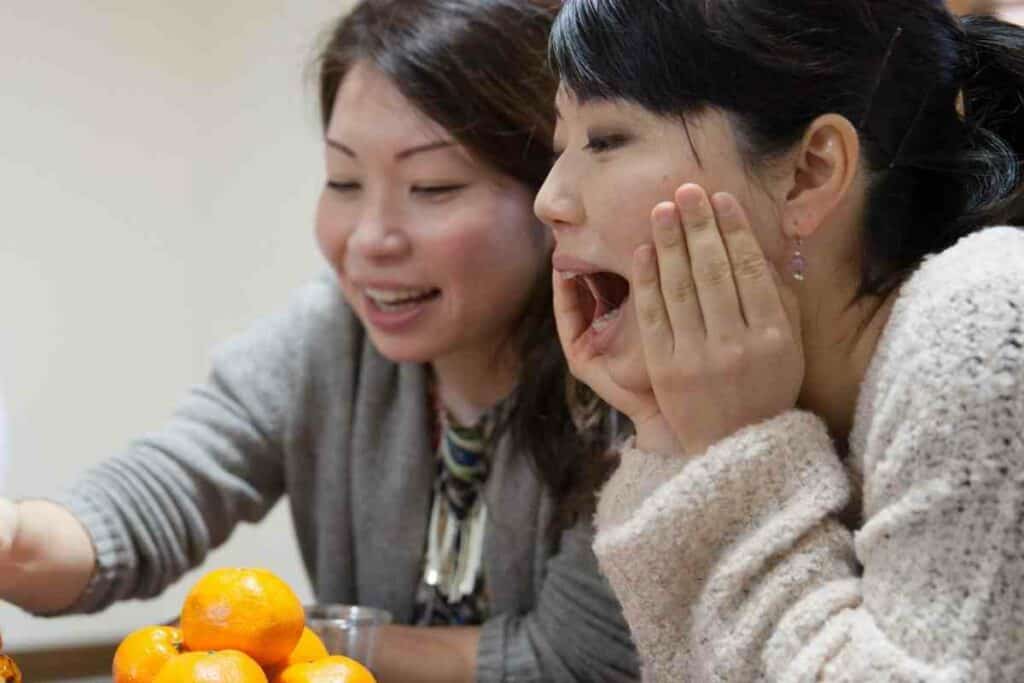
These gifts for house visiting are called omiyage and can be anything from small cakes and sweets to a simple ornament or floral display.
Your host will appreciate you offering your special gift with a small bow as it shows that you are grateful for their invitation.
34. Offer to help your host after eating
After feasting on Japanese cuisine (with the impeccable table manners shared above), make a point of at least offering to assist the host in clearing away the dishes at the end of the meal.
Nice Tip – The Japanese value considerate behavior like this and you will be well-remembered as a guest.
Rounding up
We hope you find this list of etiquettes for getting around in Japan helpful on your next trip.
Remember, everything in Japanese culture is about being considerate and honoring and being in harmony with others.
Use this simple and admirable foundation to recall the best ways to conduct yourself while living, working or traveling in Japan.
- 12 Things Tourists Should NEVER Say in Japan
- Kissing Robot: Exploring the Popularity of the Chinese Kissing App
- Unlocking the Secret Dating Rituals Only Locals Know in Japan
- Samurai Armor: Ancient Protection for Japan’s Elite Warriors
- 10 Amazing Facts About Schools in Japan: Unique Traditions and Educational Practices
- Where can you see snow monkeys in Japan: Best locations and viewing tips









